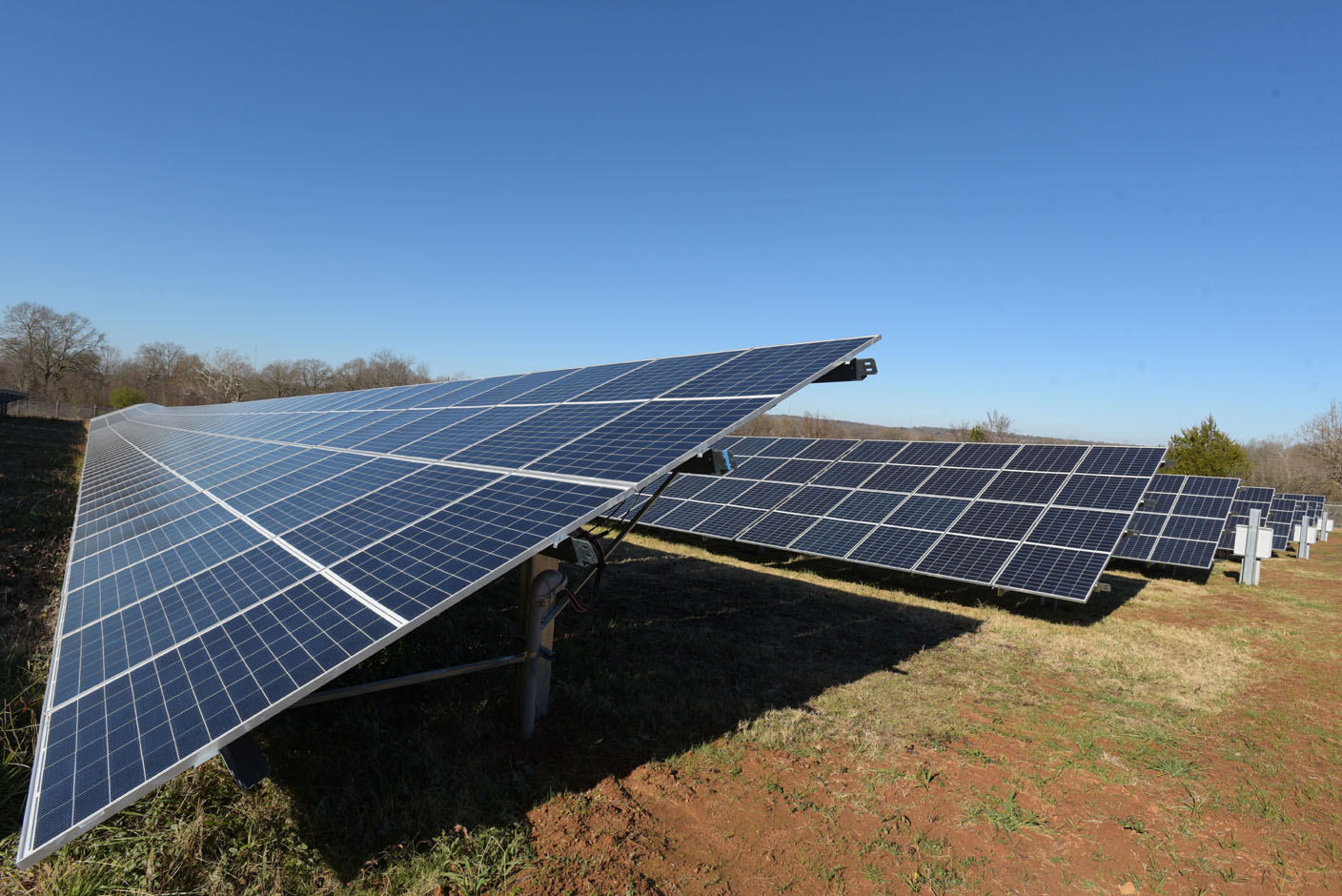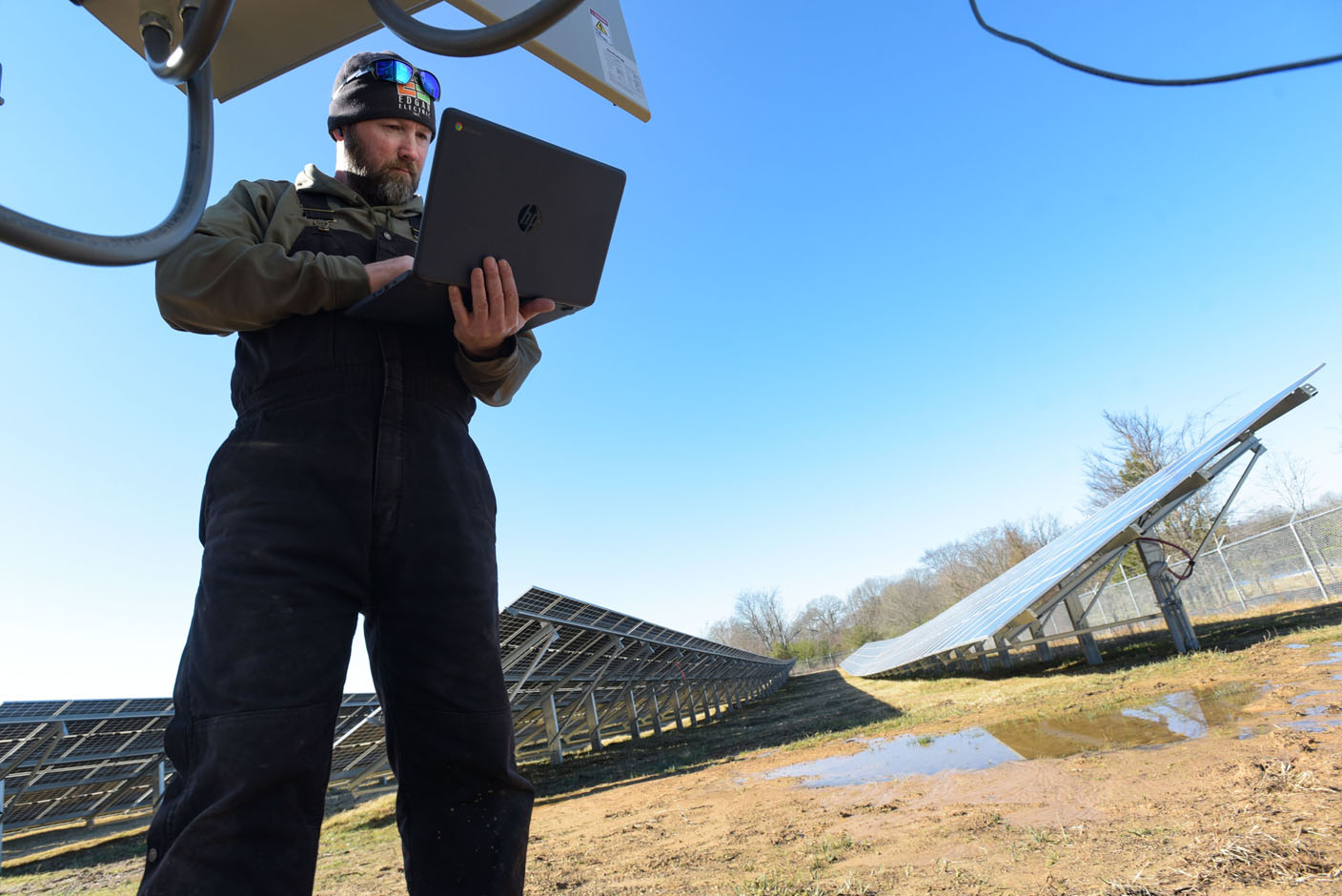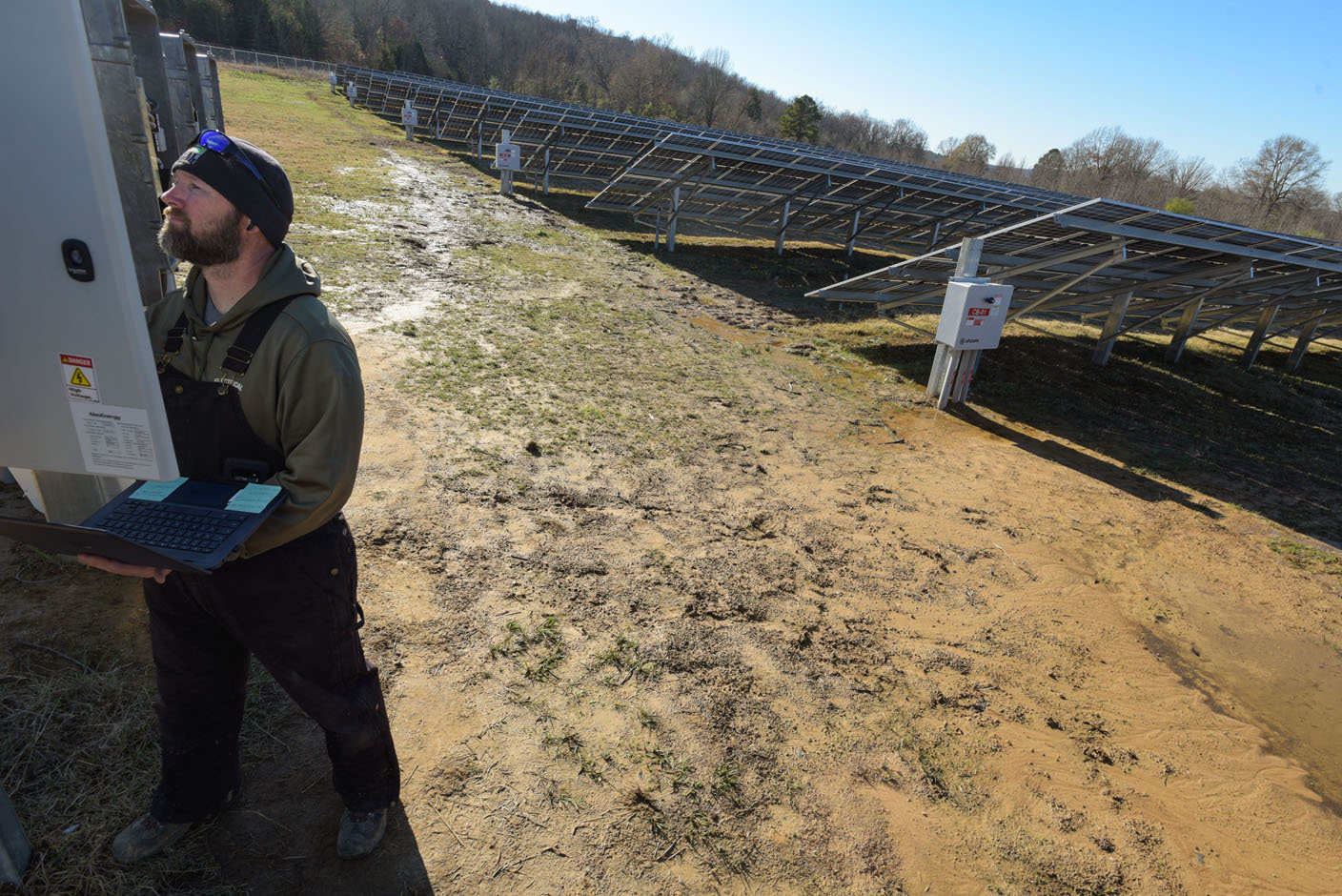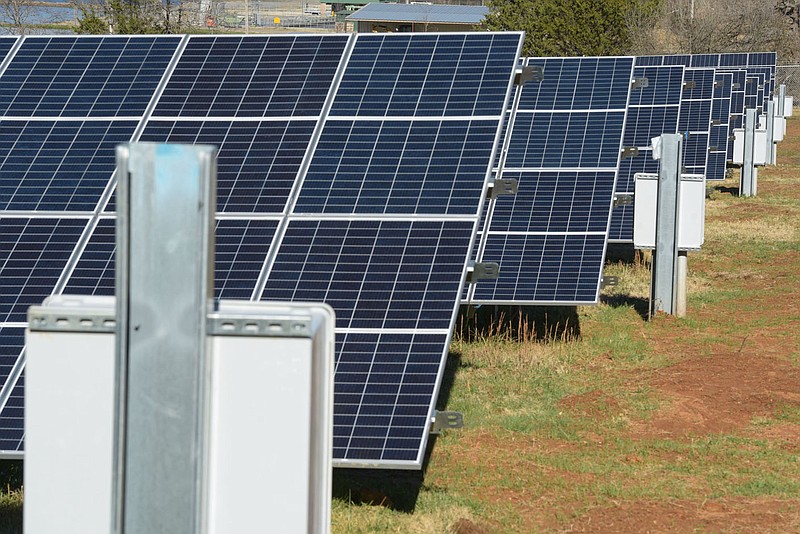FORT SMITH -- The implementation of solar energy -- along with the expectation of cost savings -- has been spreading through city and county facilities in the River Valley.
Greenwood held a ribbon-cutting ceremony Nov. 30 for the first of two solar power plants to be used for municipal buildings. The facility is on city-owned property at 606 Jayhawker Lane and supplies electricity for 98% of Greenwood government operations in the Arkansas Valley Electric Cooperative service territory, according to the city. This includes the city's Fire Station 2, Ed Wilkinson Community Pavilion and wastewater treatment plant and office.
Mayor Doug Kinslow expressed hope the second facility will be operational by spring. This will power City Hall, the police and fire departments and the water plant, as well as the shop buildings for the water, wastewater and street departments in the Southwestern Electric Power Co. service territory.
Tom Marsh, Greenwood's finance director, said it's estimated that these two plants combined will save the city more than $2 million over 30 years. Kinslow said the city will be able to reinvest this money in other things, in addition to reducing its carbon footprint.
"We don't have a set plan of said power savings going toward streets or anything like that, but obviously, the less money you spend in paying utility bills, we have that much more money to operate," Kinslow said.
Sebastian County also has been moving toward solar energy. A new solar array in Midland began operating Oct. 5, according to County Judge David Hudson, supplying energy for county buildings in Greenwood powered by Southwestern Electric Power Co., including the Greenwood Courthouse and the county Road Department and EMS facilities.
Hudson estimated that another solar energy site -- in a rural, unincorporated area on Arkansas 22 near Lavaca -- is nearly complete. It is expected to go live Jan. 21 and power county facilities -- such as the Fort Smith Courthouse and the county courts building, in addition to the county's properties at Ben Geren Park -- in Fort Smith under Oklahoma Gas & Electric Co.
McKinstry, a Seattle-based company with an office in Little Rock, is managing this project, Hudson said. The company guaranteed a cumulative net savings of $444,906 for the county from the project over 20 years.
"In evaluating the cost of electric bills supporting all of our properties versus the cost of implementing solar and reducing those costs, even with the expense of investing in the solar equipment in the solar option, financially, the county came out ahead by pursuing solar energy," Hudson said. "It was a way to help operate county government more efficiently."
This comes after Clarksville and Alma both developed solar power facilities within the past couple of years in collaboration with outside companies.
Bill Halter, chief executive officer of the Little Rock-based Scenic Hill Solar, said the two solar power plants his company built for Clarksville Connected Utilities are among the largest of their kind in Arkansas. They also resulted in Clarksville being the first community in the state whose governmental operations were completely solar-powered.
These facilities, one 6.5 megawatts and another 2.86 megawatts, were completed in 2017 and 2019 respectively, Halter said.
Alma held a "flip the switch" event in February for a solar array to power the city's wastewater treatment facility and a city-owned lift station. This was the first phase of a 28-year solar services agreement with Entegrity Energy Partners in Little Rock, according to Mayor Jerry Martin.
Martin said it is hoped phase two of the project, a solar array to power the rest of the city's municipal buildings, will be up and running by the third quarter of 2022. The project was designed to offset about 80% to 85% of the city government's total electric consumption.
GREENWOOD
Kinslow said the groundbreaking for Greenwood's new solar power plant was held May 19. The city's public-private partnership with Scenic Hill Solar to build two of these facilities was announced in January after the city entered into a 30-year contract with the company the previous August.
Halter said Scenic Hill Solar will build, own and operate both facilities while selling electricity to the city of Greenwood. The company is responsible for all construction, operation and maintenance costs. The first project has an appraised value of about $1.5 million while the second project's is about $400,000.
Greenwood's only investment for this was about $40,000 for 10 acres to accommodate the first facility, Kinslow said. The second plant will be on city-owned property at 850 Marymont Drive.
Marsh said Scenic Hill Solar will provide the energy the plants produce to Arkansas Valley Electric Cooperative and Southwestern Electric Power Co. as kilowatt hour credits. The kilowatt hours the city will use through the municipal buildings in the service territories of these two companies will achieve the credits against what Scenic Hill provided to them.
"During the year, for the months that we have more net credit than we have use, we will only receive an admin bill from Arkansas Valley and SWEPCO," Marsh said. "We do not receive a bill for the actual energy because it was provided to them through Scenic Hill Solar, through our panels."
The city's agreement with Scenic Hill Solar gives the city the option to purchase the two facilities after six years of operation, according to Marsh.
The two plants, which contain more than 2,300 solar modules combined, will produce more than 40.2 million kilowatt hours of electricity over 30 years, according to a city news release. The electricity they will create will satisfy half the electricity consumption for city governmental operations.
SEBASTIAN COUNTY
Hudson said Sebastian County's solar energy project with McKinstry was authorized in September 2019. The cost of the project is about $2.6 million. The county made a $600,000 down payment from one of its reserve accounts and financed the remaining balance of about $1.9 million over 20 years.
The county's two solar facilities will have more than 4,000 solar modules combined, according to specifications provided by Hudson.
The solar energy generated by these sites, like the system in Greenwood, will be stored and credited in coordination with either Southwestern Electric Power Co. or Oklahoma Gas & Electric Co. depending on the facilities, Hudson said. The county will also get credit for any excess energy these arrays generate.
However, Sebastian County's solar power systems belong to the county, Hudson said.
 A solar power plant is seen on Wednesday, Dec. 22, 2021, in Greenwood. Built by the Little Rock-based Scenic Hill Solar on land owned by the City of Greenwood, this 750 kW power plant is the first of eventually two such facilities that will supply electricity for city buildings. Visit nwaonline.com/211226Daily/ for today's photo gallery. (NWA Democrat-Gazette/Hank Layton)
A solar power plant is seen on Wednesday, Dec. 22, 2021, in Greenwood. Built by the Little Rock-based Scenic Hill Solar on land owned by the City of Greenwood, this 750 kW power plant is the first of eventually two such facilities that will supply electricity for city buildings. Visit nwaonline.com/211226Daily/ for today's photo gallery. (NWA Democrat-Gazette/Hank Layton) Chris Andrews, an electrician for Edgar Electric, works on Wednesday, Dec. 22, 2021, at a solar power plant in Greenwood. Built by the Little Rock-based Scenic Hill Solar on land owned by the City of Greenwood, the 750 kW power plant is the first of eventually two such facilities that will supply electricity for city buildings. Visit nwaonline.com/211226Daily/ for today's photo gallery. (NWA Democrat-Gazette/Hank Layton)
Chris Andrews, an electrician for Edgar Electric, works on Wednesday, Dec. 22, 2021, at a solar power plant in Greenwood. Built by the Little Rock-based Scenic Hill Solar on land owned by the City of Greenwood, the 750 kW power plant is the first of eventually two such facilities that will supply electricity for city buildings. Visit nwaonline.com/211226Daily/ for today's photo gallery. (NWA Democrat-Gazette/Hank Layton) Chris Andrews, an electrician for Edgar Electric, works on Wednesday, Dec. 22, 2021, at a solar power plant in Greenwood. Built by the Little Rock-based Scenic Hill Solar on land owned by the City of Greenwood, the 750 kW power plant is the first of eventually two such facilities that will supply electricity for city buildings. Visit nwaonline.com/211226Daily/ for today's photo gallery. (NWA Democrat-Gazette/Hank Layton)
Chris Andrews, an electrician for Edgar Electric, works on Wednesday, Dec. 22, 2021, at a solar power plant in Greenwood. Built by the Little Rock-based Scenic Hill Solar on land owned by the City of Greenwood, the 750 kW power plant is the first of eventually two such facilities that will supply electricity for city buildings. Visit nwaonline.com/211226Daily/ for today's photo gallery. (NWA Democrat-Gazette/Hank Layton)More News
NoneSolar Power Plant Sizes
Greenwood
• Arkansas Valley Electric Cooperative facility: 750-kilowatt direct current
• Southwestern Electric Power Co. facility: 200-kilowatt direct current
Sebastian County
• Southwestern Electric Power Co. facility: 213.3-kilowatt direct current/200-kilowatt alternating current
• Oklahoma Gas & Electric Co. facility: 1.35-megawatt direct current/1-megawatt alternating current.
Sources: City of Greenwood and Sebastian County
